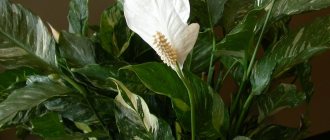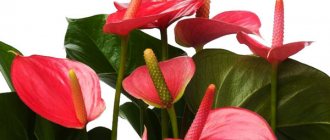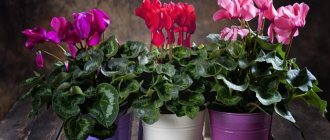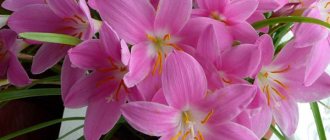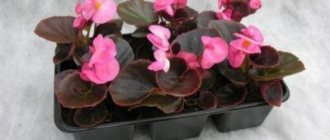Spathiphyllum was first discovered and described by the German botanist and enthusiast Gustav Wallis back in the 19th century.
The plants that attracted the attention of the scientist are still common in Colombia and other countries in the region. Many spathiphyllums can be seen along the swampy shores of reservoirs, in the undergrowth of tropical rainforests. The plant, which came to the USA and Europe, attracted the attention of flower growers. As an indoor plant, spathiphyllum has become well known throughout the world. But breeding work to develop new varieties and hybrids began relatively recently, only in the mid-60s of the last century.
The appearance of plants suitable for growing indoors:
- dwarf and impressive sizes;
- with leaves of various shapes and colors;
- having a pleasant smell;
- capable of blooming for a long time and almost constantly, caused a serious increase in interest in the culture.
Today, amateur flower growers have dozens of varieties of spathiphyllum at their disposal, photos of which allow them to constantly be amazed at the diversity of nature.
Features and photo of spathiphyllum flower
Spathiphyllum, like many plants living in tropical and subtropical zones, does not shed its leaves all year round, remaining green and attractive. The leaves of the plant are quite large, elongated-lanceolate, with depressed veins and a glossy surface.
Since spathiphyllum has practically no stem, or it is very shortened and spreads along the ground, the leaves rise directly from the ground. And during the flowering period, graceful peduncles with white bracts surrounding a white or yellowish cob rise above the plants. Contrary to popular belief, the photo shows not a spathiphyllum flower, but its inflorescence. But small flowers collected in a cob have neither petals nor external attractiveness.
Therefore, during the course of evolution, the plant acquired a white and then green bract. It is like a flag, attracting the attention of insects. Today, botanists know more than four dozen species of spathiphyllum. Only a few varieties are used as indoor crops and for landscaping. The most common inhabitants of window sills are plants belonging to the species Spathiphyllum Floribundum and Wallisii.
Popular questions and answers
We talked with agronomist-breeder Svetlana Mikhailova about what other difficulties may await the owners of spathiphyllums .
How to choose a flower of female happiness (spathiphyllum)?
When choosing a plant, pay attention to its health - the leaves should be richly colored, without spots or signs of pests. If possible, remove the spathiphyllum from the pot and inspect the roots. If there are signs of decay or the soil smells like a swamp, it is better not to take the plant.
What kind of pot is needed for the flower of female happiness (spathiphyllum)?
Not very spacious - in large volumes, spathiphyllum soil blooms very poorly and does not last long, they like close quarters. If the plant is large, it is better to choose heavy pots, for example clay ones - they are more stable than plastic ones, and most importantly, the soil dries out faster in them, which eliminates stagnation of moisture and rotting of the roots.
Why do the leaves of the flower of female happiness (spathiphyllum) turn yellow?
Most likely, the spathiphyllum is too dry and lacks air humidity. No matter how correctly you water it, spraying is necessary. Ideally, you need a humidifier. Don’t forget that “women’s happiness” comes from the humid jungle. You can put moss in the tray to keep the roots moist. Yellowing leaves can also be a sign of root rot.
Why do the leaves of the flower of female happiness (spathiphyllum) turn black?
In the vast majority of cases, blackened leaves indicate an excess of moisture - the plant has been flooded and its roots have begun to rot. In this case, all affected leaves must be removed and the spathiphyllum transplanted into a new pot.
Why do the leaves of the flower of female happiness (spathiphyllum) dry out?
Leaves may dry out if there is a lack of moisture - perhaps the plant has not been watered for a long time. The tips of the leaves dry out when the air is too dry, as well as when there is insufficient lighting. Dry spots on the leaves are a sign of sunburn. This happens if water gets on the plants in direct sunlight.
Why doesn't spathiphyllum bloom?
Do not forget to remove the faded arrows in time as soon as the bedspread begins to turn green. The longer you keep such green inflorescences, the more vitality they draw from the plant and the fewer flowers there will be. Also, the plant may not have enough nutrition - try feeding it.
Spathiphyllum pleasant
If you compare pleasant spathiphyllum or Spathiphyllum Blandum with the previous representative of the genus, the difference in the shape and structure of the leaves is immediately noticeable. This large spathiphyllum, growing in the wild in Suriname, has oblong elliptical leaves with clearly visible depressed veins. The length of one leaf reaches 30 cm. The petiole is the same size, attached to the underground creeping stem of the plant.
A greenish, up to 20 cm long bract and inflorescence-cob is located at the top of a short peduncle. Flowers appear regularly, and with proper care the plant blooms constantly.
Step-by-step instructions for care at home
The indoor plant does not require special conditions, but for lush flowering, spathiphyllum needs to follow the subtleties of care.
Selecting a location
The pot with the plant must be placed in a well-lit place, but not in direct sunlight. For optimal planting locations, window sills on the east or west side of the house are suitable. If there are none, then it is recommended to place the flower in partial shade.
What should the soil be like?
The soil for spathiphyllum should allow some air to pass through. You can make a mixture of:
- leaf humus;
- peat;
- expanded clay granules;
- charcoal;
- sand;
- moss sfangum;
- fern roots;
- mineral leavening agents.
You can purchase a ready-made soil mixture specially designed for the Araceae family. It is necessary to update the soil every 2-3 years. In this case, the plant should be replanted in a pot whose size exceeds the previous capacity by 2-3 cm.
Growing
The soil for growing the plant should be loose, so you should not press it too hard. It is recommended to add an equal ratio of leaf soil, humus, turf and coniferous soil to the soil. You can use flower soil for planting.
Before planting, you need to dig a small hole for the roots and carefully place the plant in it. Fertilizers or humus should be poured on top of the root system, after which it is necessary to fix the plant in the ground with soil. Once planting is complete, you need to water the plant.
Loose soil will provide air flow to the roots of the plant. To plant in a trunk, you need to separate the strongest cuttings, which should be taken by the base and placed perpendicular to the ground. In this case, you need to cut off short and weak lateral cuttings.
It is important to ensure that the plant grows evenly. You can tie it to a bar and systematically turn it towards the sun
Weak leaves need to be trimmed.
Temperature
The optimal temperature of the room in which the plant is located is +22-25°C, maximum +30°C and minimum +16°C. Temperatures below +10°C are critical.
Watering
The plant needs to be watered daily in spring and summer. In the autumn-winter period, you need to moisten the soil once every 7-10 days. For irrigation, use water without impurities. The humidity in the room should reach 50-60%. Leaves should be sprayed 2-3 times a day. You can place pallets with wet expanded clay, sand, or use a household humidifier.
Top dressing
Be sure to fertilize the flower all year round, excluding only the dormant period. Apply complex mineral fertilizers 2-3 times a month. Before flowering, it is better to use preparations with a high content of phosphorus and potassium.
Trimming
Plant care includes regular removal of yellowed leaves and inflorescences.
This is necessary to stimulate the plant to bloom again. Pruning helps prevent your indoor flower from weakening. Once every 3-4 months you need to cut off old and weak leaves. Yellowed or dried out leaf tips can be trimmed back to the green, healthy part of the plant with scissors.
Transfer
Before replanting, you should water the spathiphyllum generously and cut off the side cuttings. This is necessary for the plant to grow strong and bloom.
In a new pot you need to pour a layer of expanded clay granules 2.5-3 cm thick, followed by 1-2 cm of fresh substrate. You need to put spathiphyllum on it and fill the plant with a previously prepared soil mixture. Substrate must be added to the voids.
The soil should be compacted as the flower pot is filled. If the soil is wet after transplantation, it is not recommended to water it. In the evening, you can add 2 drops of Epin diluted in a glass of water. The drug will help accelerate the growth and adaptation of the plant.
Reference. Over the next 2-3 days, the plant does not need to be watered.
Spathiphyllum cannofolia
The Spathiphyllum Cannifolium plant has the densest and narrowest leaves of all related species, up to 40 cm long.
The front side of the bract is white, and the “back side” has a pronounced green tint. The length of the spathe of this large, attractive plant is 10–22 cm. This is twice the size of the white or yellowish cob. The peculiarities of the species are that the inflorescences have a pronounced aroma, and the cob itself is not tuberous, but smooth. In nature, plants of this species can be found in the tropical forests of South America, as well as in Trinidad.
Caring for spathiphyllum at home
Spathiphyllum can grow in diffused light and in partial shade. In the shade, spathiphyllum leaves become dark green, the leaf may take on a more elongated shape, flowering will become rare or stop.
If you find these signs, then the plant does not have enough lighting. The plant should be protected from direct sunlight; keep this in mind when placing the plant on south-facing windows. Northern windows are well suited for spathiphyllum, but on southern windows spathiphyllum blooms more abundantly and longer and is much larger in size.
Spathiphyllum is a heat-loving plant; in spring and summer it prefers temperatures within +22...+23°C, not lower than +18°C. In the autumn-winter period, the optimal temperature is not lower than +16°C, as this inhibits the development of the plant. Temperatures below +10°C are critical, as at this temperature plants rot and may die. Spathiphyllums do not tolerate drafts.
Watering
Spathiphyllum needs to be watered all year round. During flowering, in spring and summer, abundant watering is required, possibly from a tray, but the top layer of soil should dry out between waterings. In winter, watering is moderate. The earth ball should not be allowed to dry out; at the same time, stagnation of water in the pot can be detrimental to the plant.
For watering and spraying, use only settled water (it must stand for at least 12 hours). Drooping spathiphyllum leaves indicate that it lacks moisture. Excessive watering causes dark spots to appear on the leaves.
Air humidity
All spathiphyllums love high humidity. Spraying with soft water, a tray with damp moss or sand, the atmosphere of the aquarium, a warm shower from time to time - all this has a beneficial effect on the growth of spathiphyllums - natives of humid climates. It is no coincidence that the tips of their leaves are elongated into a sharp dropper and droop down: this is how the leaves get rid of excessive flows of tropical downpours.
In the dry air conditions of most rooms, even with timely spraying (2 times a day), drying of the leaf tips is observed
When the spathiphyllum blooms, it is necessary to spray it carefully so that water does not get on the cover and the cob.
From October to January the plant has a dormant period, but if it is provided with sufficient air humidity, spathiphyllum can bloom in winter.
Feeding spathiphyllum
During the active growing season (from March to September), spathiphyllums are fed with low concentration complete mineral fertilizer (1-1.5 g per liter of water). You can feed it with a special fertilizer for indoor plants that does not contain lime, for example, “Azalea”, “Flower”, etc.
Good results are obtained by alternate feeding with solutions of mineral fertilizers and fresh mullein diluted in a ratio of 1:15 or 1:20. After fertilizing and before fertilizing, the plants are watered generously with water at room temperature. If spathiphyllum blooms in winter, then it is fed with the same fertilizers after 3-4 weeks. The appearance of brown spots on the leaves indicates an excess of nutrients.
Transplantation and substrate
The signal for replanting is the roots, which have filled the entire volume of the pot with the plant. It is better to replant in the spring
Spathiphyllum is sensitive to root damage, replant carefully
The soil for replanting is slightly acidic (pH - 5-6.5). Excess moisture harms the plant, so the soil must be loose so that excess moisture can flow freely into the pan. Spathiphyllums feel quite good in ordinary humus, to which you need to add brick chips and pieces of charcoal. A mixture of equal parts of leaf and turf soil, humus, peat and river sand is suitable.
You can use a ready-made substrate for aroids by adding pieces of charcoal to it. Good drainage is necessary. Choose a pot for spathiphyllum that is slightly larger than the previous one; too large a pot will slow down flowering. It is better to spill the soil with a dark pink hot solution of potassium permanganate.
After transplantation, plants need warmth, moderate watering, and frequent spraying, all of which contribute to rapid rooting. Plants take root better if greenhouse conditions are temporarily created for them (covered with transparent material), but do not forget to ventilate them.
Spathiphyllum wallisii. Flowers Lady
Spalyphyllum spoon-shaped
Another interesting variety of spathiphyllum was discovered in Brazil. This is Spathiphyllum Cochlearispathum - a plant that grows up to a meter in height and has thin, shiny, elliptical leaves. With a width of 12–15 cm, the length of one rich green leaf reaches 30–40 cm. Moreover, the petioles are also very long and can grow up to 70 cm.
The species received its name due to the white spathe that maintains its concave shape, which becomes densely green as the cob matures.
How to determine the type of flower “female happiness”?
It is quite difficult for a beginning gardener to determine the type of spathiphyllum , since spathiphyllums are similar in structure - they have no stems, leaves on long petioles grow directly from the ground. There may even be confusion with another type of aroid plant - anthurium.
Looking at an adult plant, you can confidently determine what type of size the plant is: giant or dwarf. The difference between them is too obvious: giants grow up to 1-1.5 m, while miniature varieties reach a height of 30-35 cm. There are also spathiphyllums of medium height, in the range of 50-80 cm.
Spathiphyllum Wallis
This type of spathiphyllum, named after its discoverer and cultural champion G. Wallis, is the most unpretentious and therefore the most widespread today. The wild-growing spathiphyllum Wallis or Spathiphyllum Wallisii has become the basis for breeding work actively carried out in the world, and has presented lovers of indoor plants with a lot of the most interesting and popular varieties.
Plants of the species are small. Most of them reach a height of only 30–40 cm, which is an undeniable advantage at home. Unlike the species already described, the native of Colombia produces elongated, pointed leaves up to 24 cm in length. The petioles are flexible, long, and bend over time, and the leaves on them bend.
The inflorescences of this species do not exceed 3–5 cm in length, and the white or greenish blankets covering them become completely green as the cob develops. The spadix of the opened spathiphyllum flower is almost white or cream, and then also turns green. This species is characterized by seasonal flowering - from spring to autumn.
Over the past years, the work of breeders has brought good results, and now gardeners are familiar with not only the species found in the wild, but also spectacular varieties and hybrids of spathiphyllum.
A number of varieties, including plants of hybrid origin, can be found in flower shops today. The large spathiphyllum Mauna Loa, named after the volcano in Hawaii, is known throughout the world. The Sensation variety is also very decorative, and photos of Domino spathiphyllum invariably attract attention, thanks to the unusual variegated foliage of the plant.
Possible problems in growing
Although the flower is considered quite unpretentious in care, it can be attacked by pests, or if not properly cared for, it can get sick.
Diseases of flowers of the genus Spathiphyllum
- From a draft, the plant becomes sick and begins to shed its leaves.
- It often happens that the flowers on the plant become smaller, the leaves turn pale and growth slows down. In this case, it is necessary to provide the flower with timely application of mineral fertilizers.
- Due to too dry air, the tips of the leaves begin to dry out, so it is very important to constantly spray.
- When watering with hard or cold water, as well as insufficient soil moisture, the leaves on the flower begin to turn yellow.
- If the watering regime, lighting or fertilizing rules are not followed, the plant will stop growing and stop blooming.
Frequent pests of spathiphyllums
- Spider mite. In case of severe damage, insecticides are used.
- Shield. The leaves are washed with soapy water and treated with tobacco crumbs.
- Aphid. Treat with special chemicals.
- Mealybug. The leaves should be treated with alcohol.
Additional Information. Many people wonder whether spathiphyllum is poisonous to humans or not. When keeping it at home, you need to know: the leaves of the flower contain calcium oxalate, which causes irritation of the mucous membranes and inflammation of the eyes, so before you start caring for the flower, you need to wear gloves.
Spathiphyllum will decorate any home. Its care is minimal, it is rarely susceptible to disease, and compliance with all growing conditions will allow you to admire it for a long time.
Spathiphyllum Mauna Loa
A beautiful plant with a white wide elliptical bract, gracefully concave and covering a cream-colored spadix. Bright green, pointed leaves are held on 10-centimeter-long petioles and grow from a shortened, sometimes underground stem. Short, up to 5 cm, ears are located on high 25-centimeter peduncles.
The homeland of this spectacular plant is Colombia, from where the first samples of Spathiphyllum Wallis were exported. Mauna Loa blooms for a long time or almost constantly, the inflorescences can be cut, in this form they remain fresh for up to a month.
Diseases and prevention
You should worry about the health of your green friend if:
- The tips of the leaves become brown and dry. The reason is a draft or improper watering. If you do not correct the problem, the plant will die.
- The tips of the leaves curl - this may indicate hypothermia. In this case, spathiphyllum will not bloom. It is necessary to change the temperature regime.
- The leaves turn yellow at the edges. One reason could be hard water. Or there is a simple lack of moisture and the leaves simply dry out.
- Yellow and soft leaves, on the contrary, indicate excess moisture in the soil.
Following the rules of care, observe your plant - its appearance will tell an attentive owner a lot and suggest a further plan of action.
Spathiphyllum Chopin
One of the most popular and useful varieties of Chopin spathiphyllum, Spathiphyllum Chopin, is a universal, unpretentious plant for decorating residential interiors and landscaping offices and public buildings. The plant copes well with the task of absorbing harmful substances in the air. At the same time, the bush is very small and barely reaches 35–40 cm in height.
This variety of spathiphyllum has deep green, shiny leaves with depressed veins and pointed ends. The perianth is elongated, white, with a green tip and veins.
In addition, in the first half of the day a subtle aroma spreads from the plant, which undoubtedly adds attractiveness to the crop in the eyes of gardeners.
Description of common species and varieties
Spathiphyllum Chopin - flower description
Spathiphyllum, the species of which form a huge group, is an indoor plant - it cannot be planted in the garden in open ground.
Pointed leaves and white spathiphyllum cover
Despite the characteristic structure, the varieties of this flower can be distinguished. To do this, you need to pay attention to several parameters:
- leaf color;
- foliage size;
- flower size;
- petal shade;
- plant height.
All varieties of spaliphyllum are unpretentious in care, so you need to choose one that fits well into the design of the room and matches the scale of the green corner.
Spathiphyllum profusely blooming
Spathiphyllum Floribundum is one of the popular species, its appearance can be called classic.
Light green leaves (they are brighter on young shoots), the petiole is thin, the vein in the center is clearly visible. The length of the foliage is 20 cm, the petiole is 10 cm, the peduncles are tall, and the perianths are medium-sized. Suitable for decorating a windowsill, as it blooms all year round.
Spathiphyllum pleasant
It is distinguished by large leaves, the shape of which is more elliptical than oblong. Latin name: Spathiphyllum Blandum.
The length of the petiole and leaves reaches 30 cm, the bract is 10 cm lower. Blooms periodically, with good care - constantly.
Spathiphyllum cannofolia
This plant species, also known as Spathiphyllum Cannifolium, differs from other varieties in the elongated shape of its leaves, their structure is dense.
The white blanket can be called a giant, its length is at least 15-22 cm. Distinctive features: the inflorescences have a smell, and the spadix is smooth, not rough. It grows in the wild in South America and on the island of Trinidad.
Important! This type is perfect for landscaping a small house - it looks miniature and strict.
Spathiphyllum spoon-shaped
This variety has such an unusual name because of the shape of the white blanket: it remains curved throughout the entire growth of the plant.
It was first discovered in Brazil, it can be called a giant spathiphyllum: it grows up to 1 meter, the leaf width can reach 15 cm, and the length can be almost half a meter! The petioles can even have a length of 70 cm.
Spathiphyllum Wallis
Spathiphyllum Wallisii Regel is the most common species.
Compact parameters - height 35 cm, leaf length about 22-24 cm and inflorescences with a radius of up to 3 cm make it an excellent resident of a flower arrangement. At the same time, the leaves are elongated, on flexible petioles they eventually bend towards the ground.
Spathiphyllum Wallisii Regel
This species blooms periodically - from April to September; the white spathe becomes rich green as the cob grows. The cob also gradually changes color from cream to green. In terms of air purification benefits, it ranks on the same line with ivy Hedera Helix new.
Breeders have done a lot of work to obtain new types of spathiphyllum, which today are available on a par with the original varieties. The results were excellent, and certain varieties became very popular.
Important! We must not forget an important fact about any spathiphyllum - the plant’s homeland is in the tropics, so the care conditions do not change depending on the variety.
Spathiphyllum Lauretta
Obtained in 2001 from the Wallis variety, Spathiphyllum Lauretta new is distinguished by long stems and large leaves. Spathiphyllum royalis is also large in size.
Spathiphyllum Mauna Loa
A miniature, showy plant, Mauna Loa has elliptical bracts that completely cover the creamy spadix. The foliage is bright green in color, and its supporting petioles are up to 10 cm long. This variety is native to Colombia.
Reference! This variety blooms constantly, so that the inflorescences do not fall off, they can be cut off. They can maintain their fresh appearance for a long time with ordinary careful care.
Spathiphyllum bellini
The classic appearance of the plant distinguishes it from others: a lush, upright crown and graceful, medium-sized inflorescences. It is easy to care for and is convenient to keep in offices or on a small windowsill.
Spathiphyllum Chopin
A practical solution for the office, the Chopin variety, despite its miniature size, does an excellent job of freshening the air and decorating the interior.
Its deep green foliage has pointed ends, and long petioles (relative to the leaves) contain cobs and white spathes. Until the evening, this flower exudes a pleasant aroma, which makes it even more attractive for purchase.
Spathiphyllum Domino
Spathiphyllum Domino one is rightfully a rare find for gardeners, which needs to be cherished and placed in a prominent place. This is a rare variety; it is distinguished by its amazing-looking foliage - the emerald hue is replete with white spots.
Its height barely reaches 35-40 cm, it prefers certain growing conditions: partial shade, lack of direct rays, drafts and abundant watering. The aroma can be felt until noon, after lunch its intensity decreases.
Spathiphyllum Gemini
The bract has pointed leaf tips and variegated colors - this variety is rare.
For reference: spathiphyllums Domino and Gemini are often confused, the difference is in height - the first grows upward and looks taller.
Spathiphyllum Alfetta
An unpretentious type, Alfetta is perfect for decorating a room in a simple style.
Oval, pointed leaves and long flowering give it a special charm. Homemade specimens need to be watered regularly; this variety loves moisture.
Spathiphyllum Vivaldi
The spreading crown growing on a short stem distinguishes this variety from others. The leaves are deep green with a vein in the middle, the tips of the plates hang down. The inflorescence is cream-colored, the flowers are medium-sized.
Picture of Vivaldi
Spathiphyllum Silver Cupido
A truly tropical appearance, it has bright green foliage and large elegant inflorescences. Will refresh any interior. Spathiphyllum Silver Cupido is easy to care for. Sometimes this species is also called Pearl Cupido.
Spathiphyllum Angel Baby
It’s not for nothing that the miniature spathiphyllum Angel Baby is called that way: it is easily recognized by its narrow light leaves with sparse dark stripes. A perennial plant with elongated petals of a white blanket.
Spathiphyllum Picasso
Like Domino, this species is a successful result of the work of breeders. It is even less common and has a big difference from other varieties - the white color of the coverlet also extends to the leaves, occupying a significant area of them. Creamy streaks are visible even on the perianth!
Picasso does not require special care, it only needs uniform, dim light and regular watering.
Spathiphyllum cupido
The variety, bred in the Netherlands, is the embodiment of laconicism and minimalism: neatly shaped, pointed leaves, medium-sized white blankets on long petioles.
Cupido does not require painstaking care; it will decorate any interior without taking up much space.
Spathiphyllum Alana
A spectacular plant, Alana, has spreading but upright foliage. Having a height of half a meter, it maintains the slimness of the crown. The leaves are glossy and dark green, have distinct veining and a wide bract.
Alana
Spathiphyllum red
An inexperienced gardener is easily impressed by spathiphyllum with scarlet bracts. But the suspicion of artificial interference in the unusual shade is unfounded.
The fact is that there is a flower similar to spathiphyllum - this is anthurium. Thanks to the efforts of botanists, they can have pink, red and burgundy bedspreads.
Red spathiphyllum is actually an antarium
Additional Information! Due to the similarities between the two plants, they are often referred to by the common phrase "pece lily" in Europe.
Photo of spathiphyllum Domino
Just one photo of Domino spathiphyllum is sure to evoke enthusiastic responses and interest from indoor plant lovers. Spathiphyllum Domino is a rare plant with brightly variegated foliage with numerous white streaks and spots.
At the same time, the plant is very compact and does not exceed 35 cm in height. Like all similar varieties, the variegated variety feels great in sufficiently lit windows. Under direct rays, it may lose its attractiveness and begin to wither. Therefore, Domino requires a shading screen, good watering and no drafts. In the morning, the plant pampers the owner with an aroma, the intensity of which decreases in the midday hours.
Landing
It is recommended to plant this plant in spring. Although for representatives of the tropics, this is not important. The main requirement is that the air temperature be at least +18 degrees.
To plant Spathiphyllum seeds, you need a small container, which must first be prepared by dousing it with hot water.
What should the soil be like?
The soil should be light and loose. You can use a specialized mixture for aroid or tropical plants, mixing it with a small amount of sand.
You can prepare the soil yourself, for which you take two parts of turf soil, part of leaf soil, peat, and coarse sand.
You can add some charcoal and finely crushed bricks, coarsely ground tree bark, and coconut fiber. The total volume of additives should not exceed 5% of the total mass of the prepared soil. This allows the resulting substrate to be more breathable and moist.
How to plant?
Growing spathiphyllum from seeds is a very long process. In this case, the plant will bloom only in the third year after planting. But the advantage of such a plant will be its undemandingness to humidity, and the flower itself will be strong and adapted to environmental conditions.
Spathiphyllum should be planted in spring.
- The seeds are placed in moist, loosened soil by simple pressing.
- Containers with future seedlings are placed in a small greenhouse, which is regularly ventilated.
- To germinate seeds, a temperature of 20-25 degrees and high humidity is required.
- When the crops grow by 3 cm, they should be planted in separate pots.
- Three months after the plants have been planted, they can be fed.
Spathiphyllum Picasso
Based on Spathiphyllum Wallis, Dutch breeders obtained a variegated variety that is even more interesting than Domino. Its white color occupies entire sectors of the leaf plate. Spathiphyllum Picasso is a godsend for gardeners who do not have the opportunity to painstakingly care for plants and who love unusual crops.
The plant, like all spathiphyllums, is unpretentious and demanding only in terms of lighting, which should be bright, but not scorching. A special feature of this variety is the variegated color of not only the foliage, but also the graceful perianth with a pointed tip.
Reproduction
Seeds. After pollination of the spathiphyllum, wait until the seeds are ripe, then collect them and immediately sow them in a moist soil mixture consisting of sand and peat. Cover the container with the seedlings with a bag and transfer to a dark place with a temperature of +24...+25°C. To maintain soil moisture, moisten it regularly. During the entire period of waiting for seedlings, ventilate the mini-greenhouse daily.
By cuttings. Cut the rosette from the mother plant. Place the cuttings in water for 15–20 days until roots appear. To prevent rotting of the lower part of the shoot, add half a tablet of activated carbon to 200 ml of water. When the roots reach a length of 2–3 cm, this indicates that the young shoot is ready to be planted in the ground.
By dividing the rhizome. This method is the simplest. When you divide the rhizomes, you get ready-made plants that all you have to do is plant them in the soil. Carry out the procedure at a temperature of +20°C. Before removing the mother plant from the flowerpot, thoroughly moisten the soil underneath it - the root system will be saturated with moisture and will become less vulnerable to damage. Remove all dry and rotten roots, as well as limp leaves, from the cuttings. Plant the young bush in a container with a diameter of no more than 15 cm.
Bloom
Flowering makes Spathiphyllum stand out from the entire range of flowering plants due to its tall peduncles on a thin long stem. Many people like this flower; it has a unique appearance and, with proper care, can delight with year-round flowering, with a short winter dormant period. A large number of varieties are known, but they all have similar external characteristics.
The lack of flowering in Spathiphyllum is due to insufficient or poor lighting, and it is worth moving it to a more illuminated place; it is also necessary to protect the plant from drafts. Insufficiently high temperature or temperature changes can also affect the flowering of the plant.
Spathiphyllum Sensation
This spathiphyllum hybrid can easily be considered one of the most decorative and spectacular. Spathiphyllum Sensation bushes can reach one and a half meters in height. This makes the variety one of the largest among existing indoor varieties.
The plant has large attractive leaves of a dark, shiny color and a length of 40 to 80 cm. The large inflorescences of Spathiphyllum Sensation also greatly benefit from other similar varieties. Only appearing above the foliage, the perianths are white. Then they gradually turn green and merge into the general background. The ear is large, smoother than that of other plants. At the same time, the spathiphyllum flower, as in the photo, lasts for a very long time.
Among other tall varieties of spathiphyllum, one should note Sweet Silvio, a hybrid origin with graceful inflorescences and lush bushes up to 75 cm high. Against the background of this large variety, Strauss spathiphyllum plants, 30 cm in height, look especially miniature.
What to do if it doesn't bloom
Not every gardener's purchased spathiphyllum blooms. The reason for the lack of flowers is improper care, namely low air temperature, insufficient humidity, and deficiency of nutrients. It is necessary to ensure optimal temperature and humidity, increase the dose of fertilizing, and delicate beautiful flowers will definitely appear.
If you plant a flower in a pot that is too large, it will grow root and foliage mass, but there will be no flowers.
Replanting after purchase into a pot that is too large can also delay the appearance of flowers. Until the space of the pot is completely filled with roots, you should not expect flowering. You can correct the situation by transplanting the plant into a smaller pot.
Pests
Spider mite
A dangerous pest appears on the underside of leaf blades, covering them with cobwebs. Soon the leaves begin to dry out. The diseased plant is sprayed with a soap solution, after cleaning the leaves from cobwebs with a damp sponge.
If the solution does not help, you can use insecticides and ground sulfur. Some gardeners use the following recipe in the fight against spider mites: 100 g of onion peels are poured with 5 liters of water, left for at least 5 days. The resulting solution is sprayed onto the plant.
Aphid
Black, green or gray aphids settle at the bottom of the leaf blade and multiply very quickly. The pest feeds on the sap of the plant, as a result of which the leaves begin to dry out and curl. To kill aphids, the plant is treated with a solution of nicotine sulfate (1 g of product diluted in 1 liter of water) or a soap solution. If necessary, repeat the treatment.
Shchitovka
When attacked by a scale insect, the leaf blades become covered with dark spots. The plant is treated with a soap solution with the addition of tobacco and kerosene. Then wash the flower with a clean soap solution and insecticides.
Mealybug
Mealybugs appear between the leaves due to excessive dampness. If there are not many insects, they can be easily removed with a cloth soaked in alcohol. In case of severe infection, the plant must be treated with actellik, insecticides or infusion of citrus fruit peels.
During treatment, you need to make sure that the solution does not get into the soil, otherwise not only the pests will die, but also the flower itself. After treatment, the plant is washed, and the ground is also covered with film.
Causes of blackening and yellowing of leaf tips
Many housewives of spathiphyllum complain that the tips of the leaves begin to turn black, and sometimes the flowers themselves turn black. The reasons for this state of the flower are banal:
- Insufficient watering. As already mentioned, the first sign of insufficient watering is drooping leaves. If the leaves droop, then you urgently need to water the plant generously, collect and lift the leaves, and fix them in this state. This can be done using a regular bag or cling film. The leaves will not rise to the same height after watering on their own, so in order for the flower to take on its original appearance, it is necessary to fix the leaves at a height.
- Excessive watering. The tips of spathiphyllum leaves begin to turn black due to excessive watering or humidity. The soil should not be constantly abundantly moistened. There must be moderation in everything; you must intuitively understand when a flower needs moisture. You can check whether the roots are wet or dry by lowering your finger two phalanges deep into the pot. If the roots are wet and the top layer of soil is dry, then the leaves of the spathiphyllum flower turn black due to overwatering.
- Direct sunlight on the leaves of the flower. Direct exposure to sunlight can burn the leaves, they will begin to turn yellow, blacken and dry out.
- Lack of nutrients. The flower of female happiness signals a lack of minerals by blackening the tips of the leaves. Periodically fertilize the root system or leaves with a special product.
In order for the spathiphyllum flower to bestow feminine happiness on its owner, home care for the flower must be correct. Do not let the leaves droop or turn black. Only when it blooms in a healthy way does it bring happiness to the home.
Spathiphyllum red
Sometimes you can hear that nurseries offer spathiphyllums with red or pink bracts. However, before you succumb to a tempting offer and rush to purchase a rare flower, it is worth understanding the classification.
A white bedspread can only become colored under the influence of chemicals artificially introduced from the peduncle. Under natural conditions, the bract can only turn green. And yet there are plants that are closely related to spathiphyllum and have colored perianth. These are anthuriums well known to gardeners. Thanks to breeders, depending on the variety, they are able to please the owner with scarlet, burgundy, pink and almost white covers of inflorescences.
Spathiphyllum and anthurium have many common morphological features. Therefore, in the West, the common name is applied to plants - peace lily. By the way, if spathiphyllum is considered a talisman of female happiness, then anthurium is the embodiment of male well-being and strength. Although we have not yet managed to obtain red spathiphyllum, these plants can become a good pair and complement each other on the windowsill.
Signs and superstitions
The spathiphyllum flower “female happiness” speaks for itself.
According to signs, a “lady’s flower” can bring happiness and good luck to a woman who is looking for love. A flowering bush promises quick changes in your personal life, which will bring new meetings, joy and success on the personal front.
An ancient legend says that the first plant came to earth as a gift.
The goddess Astara gave an unusual flower to an ordinary earthly girl on her wedding day. After some time, the girl found her love and got married, and gave the flower to her sister.
Thus began the journey of spathiphyllum around the world, it brought happiness and love to its owners and did not demand anything in return.
Signs and superstitions:
- If “female happiness” blooms in the house of an unmarried girl, then she will meet her love and get married.
- For a married couple, flowers on a plant portend pregnancy and the birth of children.
- It is generally accepted that the flower is sensitive to care and attention from the owner. In return, he can fulfill your deepest desires.
- If you place a pot of anthurium “male happiness” next to the spathiphyllum, then harmony, happiness and love will reign in the family.
- It is bad luck to give your flower to anyone.
- It is a good sign to receive a plant as a gift from a man, regardless of who he is to the new owner of the flower.
- It is best to buy a new plant from female sellers. In addition, women's days are the best time to buy a plant.
There are no negative signs associated with the plant. Therefore, you can buy or accept a perennial as a gift without fear of destroying the energy of the apartment.
With proper care, spathiphyllum will fill your home with joy and your hearts with love.
Pests
The first pest of spathiphyllum is the spider mite. It affects young animals. It is easy to identify the parasite by detecting the web. Treat the plant affected by the insect with a soap solution and insecticides.
The second pest is the scale insect. A dangerous disease that can kill a crop. If raised spots appear on the bottom of the leaves, you should remove the flower from other representatives of the indoor flora and treat it with soapy water or tobacco crumbs. The most damaged leaves are removed. If necessary, resort to the use of chemicals.
The third, no less dangerous parasite of spathiphyllum is the aphid, which is especially active in the summer. To combat the insect, the leaves are treated several times with a special solution.
The fourth enemy of women's happiness is the mealybug. The pest hides between the leaves. One by one, individuals are removed with cotton wool soaked in alcohol. Large insect colonies are eliminated with special preparations.
Bloom
Despite the fact that Alana belongs to the spathiphyllums, the variety differs significantly from other varieties of this plant, including in terms of flowering.
When and how does it bloom?
The buds are inflorescences-cobs, wrapped in a delicate blanket. The beginning of flowering is observed in March-April, and its duration is about 2-3 weeks. With quality care, Spathiphyllum Alana blooms twice a year .
Care before and after flowering - features
- During flowering, spathiphyllum Alana must be watered abundantly with well-settled water so that the soil does not dry out.
- Fertilizers are applied once every 14 days. It is prohibited to use fertilizers that contain high concentrations of potassium and phosphorus.
- All faded buds are removed.
- After flowering, the bush is pruned, the amount of fertilizer applied is reduced and the frequency of watering is reduced.
What to do if buds do not appear?
Most often, the lack of buds is associated with poor quality care of the plant, especially low temperature, humidity, and lack of nutritional components.
This situation can be eliminated by following a number of recommendations:
- provide comfortable temperature and humidity;
- increase the dose of applied nutrients;
- When replanting a plant after purchase, it is recommended not to use a container that is too large.
